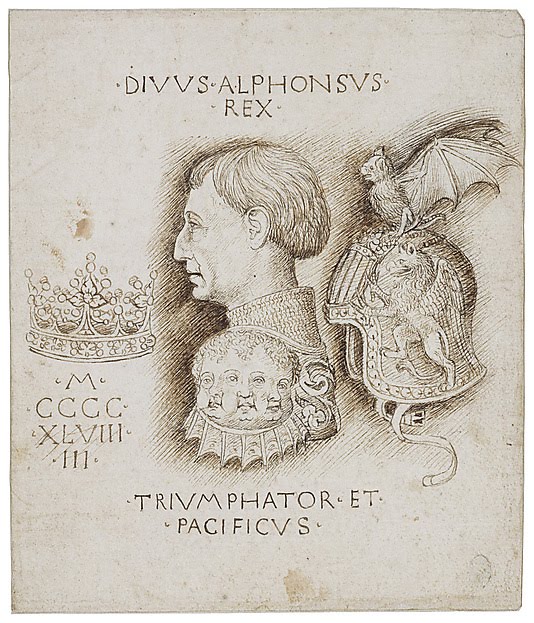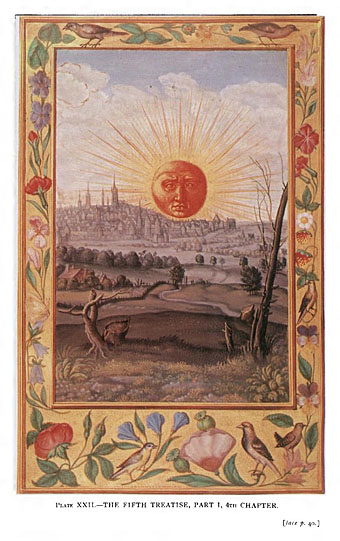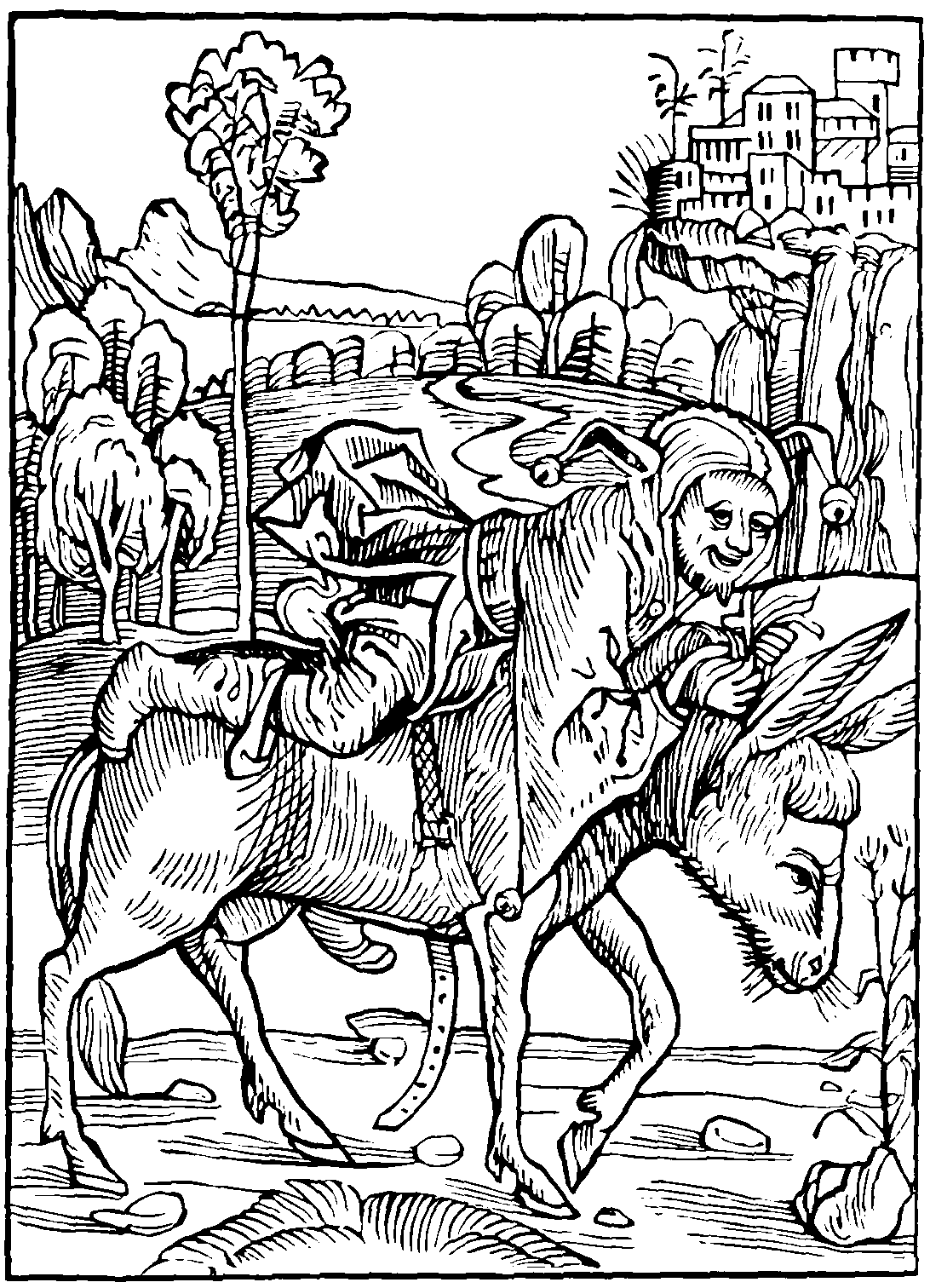So... you are objecting to a conclusion without an explicit disclaimer? I need to announce that it was a conclusion based on evidence and argument rather than an observation of objective fact? Okay: It is a mere conclusion based on my imperfect knowledge and understanding of the minuscule amount of fragmentary evidence that exists, yada-yada blah-blah-blah.Huck wrote:Hm. I call the 5x14-theorie a 5x14-theory, not a fact.... You claim definitely, that the Ur-Tarot hadn't Fame (and this is stated, as if it is not a theory), and I'm interested to know, how you could do so.mjhurst wrote:Given your obsession with phantom 5x14 decks and Chess and so on, you ask a question like that? Okay. I'll explain my right to draw conclusions with which you may disagree: It's the same right that you rely on to draw conclusions with which I disagree. Fair enough?
I could point out that this is a silly, disingenuous complaint, given the fact that virtually everything asserted in this forum would require the same disclaimer, over and over. I could point out that you make all manner of claims without including that sort of disclaimer. For example, you seem to state as fact that every Tarot writer who has discussed the C-Y trumps has been mistaken about the World card being a "World" card.
I could point out that in the very paragraph from which you cut that snippet, I began with facts, and explained my reasoning. That is, evidence and argument were presented before that conclusion, making it obvious that it was a conclusion based on those facts and reasoning. Unfortunately, taking things out of context and distorting them is one of your special skills, so naturally you ignored the main points of the paragraph, including that which contextualizes the parenthetical clause you quoted. Here is the quote, in context.
The italicized sentence is the logic of the argument. When you ignored my argument and challenged my conclusion, I restated it in the passage you quoted above -- explicitly in terms of conclusions, not facts. Do you think I'm claiming divine revelation or something?Michael wrote:Let me add that it would not have been unusual for the World to be conflated with Fame, even though that is not apparent in the Cary-Yale deck. If we look at different decks we can find various cards conflated with Fame, including Temperance and Judgment, and perhaps other cards as well. This is an inherently Petrarchian conflation, and illustrates both a key difference between Petrarch's allegorical cycle and Tarot's (the Ur Tarot did not have a Fame card) as well as the pervasive influence of Petrarch's scheme. Both Fame and Prudence were clearly missing from the original design, which is why they were sometimes added as secondary allusions. But the Cary-Yale World card, showing at its center a heavenly crown and following the Last Resurrection, is something which puts worldly Fama to shame as a worthless vanity.
The facts and argument explain the conclusion. Why is that a mystery to you?
Ah, the 14 original Visconti-Sforza trumps. Okay, one more time. We have a deck, usually called the Visconti-Sforza Tarot, in which only 14 of the original set of trumps survive, although most of the suit cards are extant. These appear to have been painted by a member of the Bembo family, probably Bonifacio. It is worth noting that numerous copies of the Visconti-Sforza style were made over the years, and the probability is that they came from a single Bembo-family workshop in Cremona. This is consistent with Dummett's observations, and the suggestions of his source, Winifred Terni de Gregory, (Bianca Maria Visconti, duchessa di Milano, 1940).Huck wrote:I know all 14 trumps, and the definition, why I take just these 14 trumps, is not done by me, but by a majority of researchers, who claim, that these all are were painted by one painter in contrast to 6 other cards of anther painter in the PMB. The cards are all given, and one can see them.
It is worth noting that this request was about the same time period when the Visconti-Sforza deck is thought to have been made, so Gismondo's deck would probably have looked rather like the V-S deck, except for the likelihood that some heraldry would have been changed.Dummett wrote:From a letter of 1451 from Bianca Maria Visconti to her husband Francesco Sforza, asking him to send to Sigismondo Malatesta, lord of Rimini, a pack of Tarot cards of the kind made in Cremona, which he had asked for the previous autumn, we may infer that Cremona was especially renowned for hand-painted playing cards of this kind.
An incomplete deck is perfectly normal. The Rosenwald, Cary Sheet, and Rothschild/Beaux Arts printed decks are all incomplete, as are the Charles VI, Este, Leber-Rouen, other Visconti decks, and so on. The distinguishing feature of the V-S deck, in this regard, is that it has six trump card made at a later date in addition to the 14 original ones. Terni de Gregory suggested that the brothers, Benedetto and Bonifazio, may both have been involved in painting the Visconti-Sforza deck -- one for the original commission and the other for the replacement cards some years later. This too is wholly expected, perfectly reasonable.
One of the first mentions of playing cards in Florence, about two decades before Tarot was invented, names Iacobo di Bartolomeo Sagramoro, a painter frequently employed by the Este. He was owed 6 lire for repairing four decks (painting the backs red) and making thirteen replacement cards from scratch, five of them with figures and eight with pips. Ortalli noted, “Since old packs were being repaired in 1422, we can reasonably suppose that the games concerned had already taken root for sometime.” Luxury decks of regular cards were being repaired long before Tarot decks were even invented, so there can be no doubt that they too would have their damaged cards replaced. It is also not surprising that our most nearly complete early deck, i.e., our best maintained early deck, is also one which included replacement cards. This too is wholly expected, perfectly reasonable.
There is no mystery here... never has been.
Is that a "fact"? No.
It is a simple (even obvious) conclusion based on evidence and argument. If this simple conclusion is rejected, then a whole world of otherwise-unnecessary speculation is required to support a very complex and unsubstantiated evolutionary hypothesis. You reject simple explanations (like replacement cards) and then make up unnecessary scenarios to explain what was better explained without them. After a couple decades, you still haven't offered a coherent alternative universe, so we are left with what Ross has dubbed the Standard Model of Tarot history. That is the history laid out in detail by Dummett and elaborated upon by other playing-card historians. It permits parsimonious explanations.
The earliest playing cards were playing cards.Huck wrote:You claim definitely, that the Ur-Tarot hadn't Fame (and this is stated, as if it is not a theory), and I'm interested to know, how you could do so. With the fixation, that it should contain playing cards you don't tell anything about the motifs. If you don't know the motifs, you can't exclude, that Fame wasn't part of the motifs. When you fix the definition of "Ur-Tarot" on playing cards,
Why is that hard for you?
Your beliefs are usually mistaken, so try not to be too surprised by the next sentence.Huck wrote:then the Michelino deck is there and it's a playing card deck. So the Michelino deck is the one or one of the category "Ur-Tarot" you're speaking of, I should conclude. But I don't remember, that this is part of your assumptions. So I've doubts, that you wanted to say that.
The 16 Heroes deck IS an Ur Tarot deck (not the Ur Tarot deck) in one specific regard: it has a set of trump cards added to a relatively normal set of suit cards. An augmented deck, created by the addition of a set of permanent trumps to a regular deck, is ONE of the defining characteristics of Tarot. In this extremely limited but important sense, the 16 Heroes deck created by Marziano for Filippo was a precursor of Tarot. Likewise, the Latin-suited regular deck was a necessary precursor of Tarot. Likewise, the Mamluk deck was also a necessary precursor of Tarot. And all of them were used to play trick-taking games. However, there are a great many trick-taking games, and trick-taking games with trumps. Tarot is one large family of such games, but it is not the entire universe of such games, and being a precursor of Tarot is not the same thing as being Tarot.
If our dating of the 16 Heroes deck (c.1420s) and the invention of Tarot (late 1430s) are approximately correct, then we must conclude that the former was a largely failed experiment. Marcello's description makes it sound like a unique novelty.
You claim to pay attention to the "game structure" of the decks, so you are well aware that essentially nothing about the 16 Heroes deck is like the corresponding aspect of Tarot decks. It had a very different set of suit cards, both in suit signs and in the numerical structure of the suits. Regardless whether you consider each suit to include four of the god cards, which appears to have been the intended idea, or whether you consider those to be completely distinct, either way the suit cards are very different than Tarot decks. The number and organization of the trump cards is completely different than Tarot decks. The absence of a Fool card with its varied but usually unique role, is another very big difference. It had a completely different set of subjects on the trump cards. It was an odd hybrid sort of design, and nothing like it (that we know about) survived.
The 16 Heroes deck had one new idea which did survive, or which was resurrected 15-20 years later in the invention of Tarot. It can be used to explain, in that sense, one aspect of Tarot.
(As an aside, the fact that the 16 Heroes deck was created by a learned courtier for Filippo Maria Visconti may be used as evidence that the Ur Tarot was probably also created in Milan, where the earliest surviving decks came from, and was probably created by a later courtier, also for Filippo. Ross has posted on Gasparino Barzizza and his son Guiniforte, humanists known for their interest in both Stoic philosophy and Petrarch. Gasparino gave a funeral oration for Marziano. Guiniforte served Alfonso V of Aragon (who enjoyed the great allegorical entry of 1443), as well as the courts of Visconti, Monferrato, and d'Este. The great Latin moral works of Boccaccio and Petrarch, (De Casibus and De Remediis), as well as their allegorical cycles (Amorosa Visione and I Trionfi) would have been dear to the hearts of both father and son. The earliest mention Ross found of Petrarch's Triumphs was in fact a mention by Guiniforte, dated 1439, Milan. And so on. Therefore, Guiniforte is my candidate for the title, Inventor of Tarot.)
Again, as usual, you reject the simple and obvious but you fail to spell out what the alternative would be. How would your theory work, exactly? The original Tarot deck had a Fame card, but people didn't like it so they changed it? Except in Florence, where Minchiate actually kept the original design.Huck wrote:I'm puzzled. Where was Judgment turned into Fame? Ah, you mean the Minchiate, okay.Michael wrote:Beyond that, I explained the reasoning behind my conclusion about the absence of a Fame card. However, I can explain it again. It is a fact that various existing Tarot decks turned different cards, (including Temperance and Judgement at the very least), into a Fame card. If there had been a Fame card in the original design, this would not have been necessary. Q.E.D.
Anyway ... how do you come to the conclusion, that Temperance or Judgment were turned into the Fame card, can't it be, that Fame was otherwise turned into other cards? Charles VI's world-prudentia-fame looks, as if Fame became a virtue, so Prudentia. As I've shown some posts ago, it looks, as if "Mondo" developed from Fama.
Some decks changed it to a Temperance card. This is real.
Some decks changed it to a Judgment/Angel card. This is real.
Some decks changed it to a World card. This is your interpretation, which may have some merit.
A problem is that Temperance, Judgment, and the World exist in pretty much all decks. For example, the Cary-Yale and Visconti-Sforza decks both have an Angel card as well as a World card. In decks where Fame became Temperance, they just added the Angel and World? In decks where Fame became the Angel, they just added Temperance and the World? How does all this work out, and how is it that in every locale, after all these speculative changes were made, they all ended up with 22 trumps and basically the same subject matter?
There is a simple and perfectly reasonable explanation, in the Standard Model of Tarot history. We know that Tarot was well established in the 1440s, in various locations. Tarot was known in various courts as well as being printed and sold as a commodity. We know that in every locale, when we learn of their designs, it turns out that they all appear to have been based on a single, earlier pattern with 22 standard trumps, what Decker et al. termed "archetypal Tarot". There is only one explanation that makes sense of that: at a very early date, almost certainly before the Visconti-Sforza deck was made, Tarot has already taken on that archetypal form.
I've answered that in three posts now. If early Tarot had a Fame card, then later designers would not have needed to modify different cards to serve as Fame. If the World had been Fame, then it would have made no sense to make Temperance or the Angel into Fame, etc. Moreover, you insist on arguing about things taken out of context. Here is the context of the Cary-Yale "Fame" card.Huck wrote:Alright, no problem. What's then a or "the one" Ur-Tarot? How can you say, that it didn't contain Fame?Michael wrote:Yes, there were precursors to all these things -- but none of those precursors can be called an Ur Tarot.

Can you tell which of these is different from the others?

One is Fame. The others, even though they had trumpets, were not Fame.
Congratulations... you are finally beginning to pay attention to Petrarch as a source/influence for Tarot.Huck wrote:Well, we've done considerable research on the point, that development of iconography of the Trionfi poem (Petrarca) and first Trionfi card notes run together around 1440. Further we've done research, that there was not so much popularity for the Trionfi poem before 1440. So the idea is given, that both strings developed in context, influencing each other, just as a working hypothesis.
Because the Tarot trump cycle is NOT a representation of Petrarch's six Triumphs. Tarot is Petrarchian in the same sense that Costa's Triumphs are Petrarchian, even though they reverse the order of Fame and Death, and fail to include Love and Time. The trumps are Petrarchian in the same sense that Thomas More's Pageants are Petrarchian, even though some of the Trionfi are omitted and others are added.Huck wrote:Now you claim to know, that Fame wasn't part of the Ur-Tarot, in contrast to the condition, that just Fame was especially popular between the six Trionfi poem motifs. How could you do so?
Moakley did a VASTLY more rational and plausible job than you have attempted, trying to make the two cycles fit, and she had to fall back on the trumps being a satire, a parody in the "merry mood of Carnival". In other words, she failed, albeit respectably. You still ignore Moakley, even though you have finally discovered (and apparently been captivated by) Petrarch's Triumphs.
Why would you assume that? As of yesterday, YOU didn't accept that! You claimed that the Ur Tarot was the same thing as trionfi motifs, which date back much earlier, and I had to argue with you to bring the subject back to Tarot. But now you say that everybody knows that Ur Tarot refers to the earliest Tarot deck, circa 1440 or a few years earlier? LOL!Huck wrote:I assume, that everybody, who hears of the terminus "Ur-Tarot" would assume "original Tarot" and I would assume, that people with some knowledge would take it as "he attempts to speak of the situation of c. 1440". But maybe you don't speak of c. 1440.
Here's an early Triumph of Caesar motif, about 150 years older than Tarot. It's still not a Tarot card.
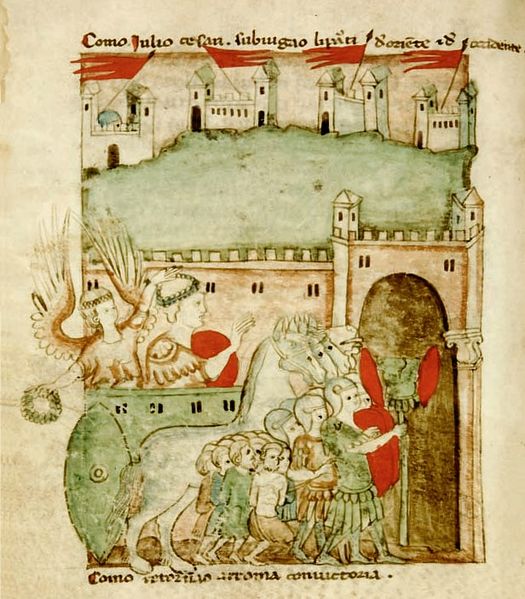
So... there are no trumpets in Apocalyptic art? Hmmm... and I thought that angels with trumpets appeared over and over and over in illustrations of the End Times. One of us is REALLY mistaken.Huck wrote:
This is my interpretation to the Cary-Yale tarocchi card, which some call World. Everybody with sharp eyes can recognize the winged trumpet, which belongs usually to Fame.
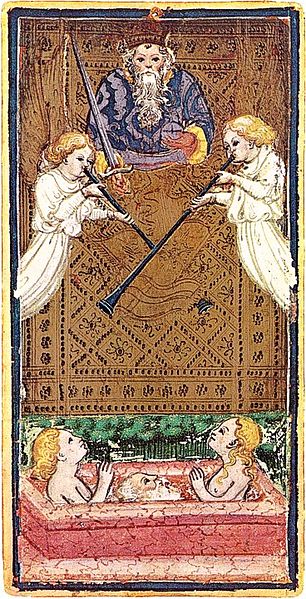

Michael


